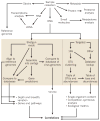Genomic approaches to studying the human microbiota
- PMID: 22972298
- PMCID: PMC3665339
- DOI: 10.1038/nature11553
Genomic approaches to studying the human microbiota
Abstract
The human body is colonized by a vast array of microbes, which form communities of bacteria, viruses and microbial eukaryotes that are specific to each anatomical environment. Every community must be studied as a whole because many organisms have never been cultured independently, and this poses formidable challenges. The advent of next-generation DNA sequencing has allowed more sophisticated analysis and sampling of these complex systems by culture-independent methods. These methods are revealing differences in community structure between anatomical sites, between individuals, and between healthy and diseased states, and are transforming our view of human biology.
Conflict of interest statement
The author declares no competing financial interests.
Figures

Comment in
-
From infection to colonization: the role of microbiota in transplantation.Am J Transplant. 2013 Apr;13(4):829. doi: 10.1111/ajt.12232. Am J Transplant. 2013. PMID: 23551627 Free PMC article. No abstract available.
References
-
- Backhed F, Ley RE, Sonnenburg JL, Peterson DA, Gordon JI. Host–bacterial mutualism in the human intestine. Science. 2005;307:1915–1920. - PubMed
-
- Possemiers S, Bolca S, Verstraete W, Heyerick A. The intestinal microbiome: a separate organ inside the body with the metabolic potential to influence the bioactivity of botanicals. Fitoterapia. 2011;82:53–66. - PubMed
-
- Shanahan F. The host–microbe interface within the gut. Best Pract Res Clin Gastroenterol. 2002;16:915–931. - PubMed
-
- Bruls T, Weissenbach J. The human metagenome: our other genome? Hum Mol Genet. 2011;20:R142–R148. - PubMed
Publication types
MeSH terms
Grants and funding
LinkOut - more resources
Full Text Sources
Other Literature Sources

